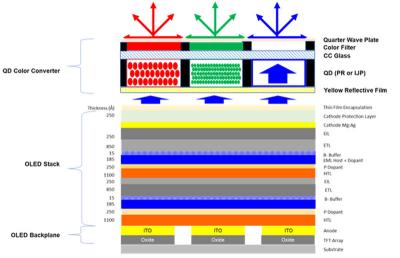DSCC estimates that Samsung will begin pilot production of QD-OLEDs in 2019, with a capacity of 5,000 monthly 8.5-Gen substrates. If this is successful, Samsung will double the capacity in 2020 and add a further 30,000 yearly substrates in 2021 and again in 2022. Material revenues for Samsung's QD-OLED TVs will reach $56 million in 2022.

DSCC admits, though, that as Samsung faces several technical challenges before it could launch commercial QD-OLED TVs, its forecast could be way off - there's a good chance that SDC will cancel the project, or it could increase capacity at a much faster rate than DSCC estimates and even scale-up production to 10.5-Gen.

The two main challenges for QD-OLEDs, according to DSCC, are efficient blue OLED emitters and a good quantom-dot color converter (QDCC). Light management in this architecture is also a serious challenge. Samsung will eventually want a phosphorescent blue or a TADF blue material - but according to DSCC at the beginning Samsung will use a fluorescent blue emitter with two emitting layers as shown above.
QD-OLEDs will offer several advantages compared to LG's current WRGB (four subpixels + color filters) system. Samsung will be able to use three sub pixels and only two emitting layers (LGD uses four), and so its stack will include 13 layers compared to 22 layers in LGD's TVs - which means fewer deposition stages, improved yields and lower material costs. DSCC estimates that a square meter of QD-OLED production will require materials that cost around $26 - compared to almost $95 in a meter of WOLED production. This is good news for Samsung of course, but could be not so good for OLED materials makers (especially UDC, at least until Samsung adopts a phosphorescent blue emitter).

